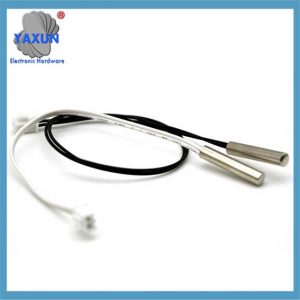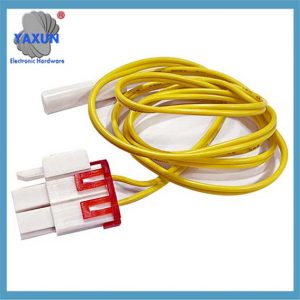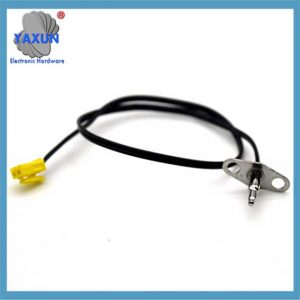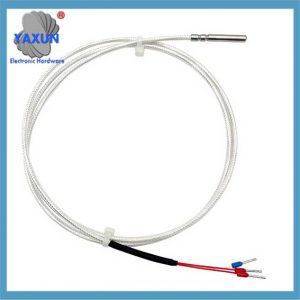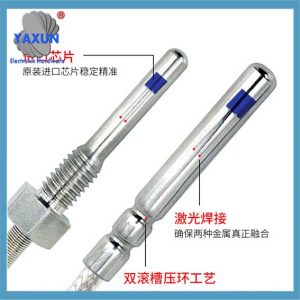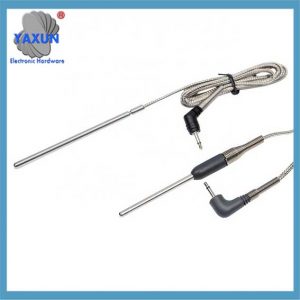én. A hőmérséklet -érzékelő alapfogalmai
1. Hőmérséklet
A hőmérséklet olyan fizikai mennyiség, amely jelzi egy tárgy forróságának vagy hidegségének mértékét. Mikroszkóposan, Ez egy tárgy molekuláinak termikus mozgásának intenzitása. Minél magasabb a hőmérséklet, Minél intenzívebb a molekulák termikus mozgása az objektumon belül.
A hőmérsékletet csak közvetetten lehet mérni egy olyan objektum bizonyos jellemzői révén, amelyek a hőmérsékleten változnak, és az objektum hőmérsékleti értékének mérésére használt skálát hőmérsékleti skálának nevezzük. Megadja a kiindulási pontot (nulla pont) a hőmérséklet leolvasása és a hőmérséklet mérésére szolgáló alapegység. A nemzetközi egység a termodinamikai skála (K). Más hőmérsékleti skálák, amelyeket jelenleg nemzetközi szinten használnak, a Fahrenheit skála (°F), A Celsius -skála (°C) és a nemzetközi gyakorlati hőmérsékleti skála.
A molekuláris mozgáselmélet szempontjából, A hőmérséklet egy objektum molekuláris mozgásának átlagos kinetikus energiájának jele. A hőmérséklet számos molekula termikus mozgásának kollektív expressziója, és statisztikai szignifikanciát tartalmaz.
Szimulációs diagram: Zárt térben, A gázmolekulák magas hőmérsékleten történő mozgási sebessége gyorsabb, mint alacsony hőmérsékleten!
2. Hőmérséklet érzékelő
A hőmérséklet -érzékelő olyan érzékelőre utal, amely érzékelheti a hőmérsékletet és konvertálja azt használható kimeneti jelzé. Ez egy fontos eszköz a hőmérséklet észlelésének és ellenőrzésének megvalósításához. Az érzékelők széles választéka között, A hőmérséklet-érzékelők az egyik legszélesebb körben használt és leggyorsabban növekvő érzékelők. Az ipari termelés automatizálási folyamatában, A hőmérsékleti mérési pontok az összes mérési pont kb. Felét teszik ki.
3. Hőmérsékleti érzékelők összetétele
II.. Hőmérséklet-érzékelők fejlesztése
A hő és a hideg észlelése az emberi tapasztalatok alapja, De a hőmérséklet mérésére szolgáló mód megtalálása sok nagyszerű férfit csapott be. Nem világos, hogy az ókori görögök vagy a kínai először találtak -e módot a hőmérséklet mérésére, De vannak olyan nyilvántartások, hogy a hőmérséklet -érzékelők története a reneszánszban kezdődött.
A hőmérséklet -mérés kihívásaival kezdjük, majd bemutatja a hőmérsékleti érzékelők fejlesztési előzményeit különböző szempontokból [Forrás: Omega ipari mérési fehér papír dokumentum]:
1. A mérési kihívások
A hőt egy egészben vagy tárgyban található energia mérésére használják. Minél nagyobb az energia, Minél magasabb a hőmérséklet. Viszont, Ellentétben a fizikai tulajdonságokkal, mint például a tömeg és a hossz, A hőt nehéz közvetlenül mérni, Tehát a legtöbb mérési módszer közvetett, és a hőmérsékletet az objektum melegítésének megfigyelésével lehet következtetni. Ezért, A hő mérési standardja mindig is kihívás volt.
-Ben 1664, Robert Hooke javasolta a víz fagyasztási pontjának felhasználását a hőmérséklet referenciapontjaként. Ole Reimer úgy gondolta, hogy két rögzített pontot kell meghatározni, És úgy döntött, hogy Hooke fagyasztási pontját és a víz forráspontját. Viszont, A meleg és hideg tárgyak hőmérsékletének mérése mindig is problémát jelentett. A 19. században, olyan tudósok, mint a meleg-lussac, aki tanulmányozta a gáztörvényt, megállapította, hogy amikor egy gázt állandó nyomás alatt melegítenek, a hőmérséklet emelkedik 1 Celsius fok és a mennyiség növekszik 1/267 (később felülvizsgálták 1/273.15), és a 0 a -273,15 ℃ fokot származtattak.
2. Figyelje meg a bővítést: folyadékok és bimetálok
A jelentések szerint, Úgy gondolják, hogy a Galileo készített egy olyan eszközt, amely a hőmérsékleti változásokat mutatja körül 1592. Ez az eszköz befolyásolja a vízoszlopot azáltal, hogy szabályozza a levegő összehúzódását egy tartályban, és a vízoszlop magassága jelzi a hűtés mértékét. Hanem azért, mert ezt az eszközt könnyen befolyásolják a légnyomás, csak új játéknak tekinthető.
A hőmérő, amint tudjuk, az olaszországi Santorio Santorii találta ki 1612. Lezárta a folyadékot egy üvegcsőben, és megfigyelte annak mozgását, amikor kibővült.
Ha néhány mérleget a csőre helyezve, megkönnyítette a változások látását, De a rendszernek még mindig hiányzott pontos egységei. A Reimerrel való együttműködés Gabriel Fahrenheit volt. Az alkohol és a higany folyadékként elkezdett hőmérőket előállítani. A higany tökéletes volt, mert lineáris reakciót mutatott a hőmérsékleti változásokra egy nagy tartományban, De nagyon mérgező volt, Tehát most egyre kevésbé használják. Más alternatív folyadékokat vizsgálnak, De még mindig széles körben használják.
A bimetall hőmérséklet -érzékelőt az 1800 -as évek végén találták ki. Kihúzza a két fémlemez egyenetlen terjeszkedését, amikor csatlakoznak. A hőmérsékletváltozás a fémlemezek meghajlását okozza, amely felhasználható egy termosztát vagy mérő aktiválására, hasonlóan a gázrácsokban használtakhoz. Ennek az érzékelőnek a pontossága nem magas, Talán plusz vagy mínusz két fok, De az alacsony ára miatt széles körben használják.
3. Hőelektromos hatás
Az 1800 -as évek elején, A villamos energia izgalmas mező volt. A tudósok felfedezték, hogy a különböző fémek eltérő ellenállással és vezetőképességgel rendelkeznek. -Ben 1821, Thomas Johann Seebeck felfedezte a termoelektromos hatást, ami az, hogy a különböző fémek összekapcsolhatók és különböző hőmérsékleteken helyezhetők el a feszültség előállításához. Davy bebizonyította a fém ellenállás és a hőmérséklet közötti összefüggést. Becquerel javasolta a platina-platinum hőelemek használatát a hőmérséklet mérésére, és a tényleges eszközt Leopold készítette 1829. A platina az ellenállás hőmérséklet -érzékelőiben is használható, Myers találta be 1932. Ez az egyik legpontosabb érzékelő a hőmérséklet mérésére.
A vezetékes RTD -k törékenyek és ezért alkalmatlanok ipari alkalmazásokhoz. Az utóbbi években a vékony film RTD -k kialakulását látták, amelyek nem olyan pontosak, mint a vezetékes RTD -k, de robusztusabbak. A 20. században a félvezető hőmérséklet -mérőeszközök feltalálása is látta. A félvezető hőmérséklet -mérőeszközök reagálnak a hőmérsékleti változásokra és nagy pontossággal rendelkeznek, De egészen a közelmúltig, Hiányzik a linearitás.
4. Hősugárzás
Nagyon forró fémek és olvadt fémek hőt generálnak, Hő és látható fény kibocsátása. Alacsonyabb hőmérsékleten, Ők is sugárznak hőenergiát, de hosszabb hullámhosszúsággal. William Herschel brit csillagász felfedezte 1800 hogy ez “bolyhos” A fény vagy az infravörös fény hőt generál.
Együttműködés Meloni honfitársával, Robelli felfedezte a sugárzó energia felismerésének módját a hőelemek sorozatának összekapcsolásával, hogy létrehozzanak egy termopilát. Ezt követték 1878 a bolométerrel. Az amerikai Samuel Langley találta ki, Ez két platinacsíkot használt, az egyik egy kar-híd elrendezésében feketézett. Az infravörös sugárzás által fűtés mérhető változást eredményezett az ellenállásban. A bolométerek érzékenyek az infravörös hullámhosszok széles skálájára.
Ezzel szemben, sugárzási kvantumérzékelő típusú eszközök, amelyet az 1940 -es évek óta fejlesztettek ki, csak egy korlátozott sávban reagált az infravörös fényre. Ma, Az olcsó pirométereket széles körben használják, és inkább lesz, amikor a termikus képalkotó kamerák ára esik.
5. Hőmérsékleti skála
Amikor Fahrenheit készítette a hőmérőt, Rájött, hogy szüksége van egy hőmérsékleti skálára. Ő állított 30 Sós víz fokos, mint fagyasztási pont és 180 Sós víz fokozva, mint a forráspont. 25 évekkel később, Anders Celsius javasolta a skála használatát 0-100, És a mai “Celsius” őt is nevezték neki.
Később, William Thomson felfedezte a rögzített pont beállításának előnyeit a skála egyik végén, Aztán Kelvin javasolta a beállítást 0 a Celsius rendszer kiindulópontjaként. Ez képezte a mai tudományban használt Kelvin hőmérsékleti skálát.
III. A hőmérséklet -érzékelők osztályozása
Sokféle hőmérsékleti érzékelő létezik, és különböző nevek vannak a különböző osztályozási szabványok szerint.
1. Osztályozás mérési módszerrel
A mérési módszer szerint, Két kategóriába oszthatók: érintkezés és érintkezés nélküli.
(1) Érintkezési hőmérsékleti érzékelő:
Az érzékelő közvetlenül érintkezik a hőmérséklet mérésére mért objektummal. Mivel a mérni kívánt objektum hője átkerül az érzékelőre, A mérni kívánt objektum hőmérséklete csökken. Különösen, Ha a mérni kívánt tárgy hőkapacitása kicsi, A mérési pontosság alacsony. Ezért, A tárgy valódi hőmérsékletének ilyen módon történő mérésének előfeltétele az, hogy a mért tárgy hőkapacitása elég nagy.
(2) Érintkezésen kívüli hőmérséklet-érzékelő:
Elsősorban az objektum hőmérsékletének mérésére szolgáló objektum termikus sugárzása által kibocsátott infravörös sugárzást használja, és távolról mérhető. Gyártási költsége magas, de a mérési pontosság alacsony. Az előnye az, hogy nem szívja fel a mért tárgyból hőt; Nem zavarja a mért tárgy hőmérsékleti mezőjét; A folyamatos mérés nem generál fogyasztást; Gyors válasza van, stb.
2. Osztályozás különböző fizikai jelenségek szerint
Ezen kívül, Vannak mikrohullámú hőmérsékleti érzékelők, zajhőmérsékleti érzékelők, hőmérsékleti térkép hőmérsékleti érzékelők, hőáramlási mérők, sugárhajtású hőmérők, nukleáris mágneses rezonancia hőmérők, Mossbauer effektus hőmérők, Josephson effektus hőmérők, alacsony hőmérsékletű szupravezető átalakító hőmérők, optikai szálhőmérséklet -érzékelők, stb. Ezen hőmérsékleti érzékelők egy részét alkalmazták, És néhányan még mindig fejlesztés alatt állnak.
100 Ohm A osztályú platina elem (PT100)
Hőmérséklet-együttható, a = 0.00385.
304 Rozsdamentes acél hüvely
Masszív átmeneti csomópont feszültségmentesítővel
Szonda hossza – 6 hüvelyk (152 mm) vagy 12 hüvelyk (305mm)
Szonda átmérője 1/8 hüvelyk (3 mm)
Három vezeték 72 Hüvelyk (1.8m) Az ólomhuzal ásósarukban végződik
Hőmérséklet minősítés : 660°F (350°C)
A PT100 sorozat RTD szondák, rozsdamentes acél hüvelyt és 100 ohm platina rtd elem. A PT100-11 elérhető 6 vagy 12 hüvelykes szonda hossza. Ezek a szondák 3 mm átmérőjű hüvelyből készülnek 304 rozsdamentes acél, egy nagy teherbírású átmeneti ízület, amely a szondát az ólomhuzalokkal és 72 hüvelyk ólomhuzal, amely színkóddal kódolt ásókágyakba végződik. Az A osztályú érzékelő elemet használják a nagy pontossági mérések biztosítására.
A PT100 szonda jól alkalmas ipari környezetre. Az RTD -k ellenállás alapú érzékelők, tehát az elektromos zaj minimális hatással van a jelminőségre. A három vezetékes ólom -kialakítás kompenzálja az ólomhuzal -ellenállást, lehetővé téve a hosszabb vezeték futását anélkül, hogy a pontosságra jelentős hatással van. A rugózott átmeneti ízület rugóhuzal -feszültség enyhítésével rendkívül mechanikusan hangos csatlakozást eredményez a huzal és a szonda között.
 English
English العربية
العربية Български
Български 粤语
粤语 中文(简体)
中文(简体) 中文(漢字)
中文(漢字) Nederlands
Nederlands Suomi
Suomi Français
Français Deutsch
Deutsch Ελληνικά
Ελληνικά Magyar
Magyar Italiano
Italiano 日本語
日本語 한국어
한국어 Polski
Polski Português
Português Română
Română Русский
Русский Slovenščina
Slovenščina Español
Español Svenska
Svenska ภาษาไทย
ภาษาไทย Türkçe
Türkçe Tiếng Việt
Tiếng Việt

